Every cook knows that a sharp knife is a safe knife. Whether you’re dicing onions, carving a roast, or prepping fresh herbs, a dull blade makes the job frustrating and even risky. That’s why a ceramic sharpening rod is one of the smartest tools you can add to your kitchen.
Unlike traditional steel honing rods that mainly realign a blade’s edge, ceramic rods go a step further by gently removing microscopic amounts of metal, restoring sharpness while keeping your knife’s edge refined and polished. They’re harder than most steels, non-corrosive, and provide a smoother, more precise sharpening surface.
But not all ceramic rods are created equal. Some are built with fine grit for polishing, while others are medium-grit for sharpening dull knives. The right choice depends on your knife collection, cooking style, and how often you sharpen. With so many options available, it can be tricky to figure out which one truly deserves the title of the best ceramic sharpening rod for your needs.
That’s where this guide comes in. Below, we’ll walk through the most important factors to consider before buying—so you can make a confident choice and keep your knives razor-sharp for years to come.
Buying Guide: How to Choose the Best Ceramic Sharpening Rod
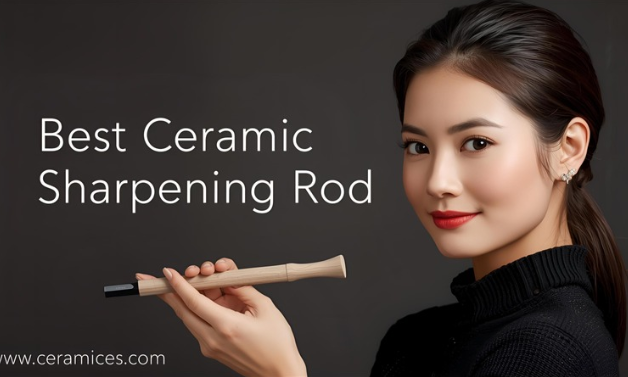
1. Rod Length
- A sharpening rod should generally be 2 inches longer than your longest knife blade.
- Common sizes:
- 8-inch rods → good for utility and santoku knives.
- 10-inch rods → versatile choice for most home cooks.
- 12-inch rods → best for professional chefs or larger chef’s knives.
2. Grit Level
- Fine grit (1000+ grit): Best for honing and polishing razor-sharp blades.
- Medium grit (600–1000 grit): A balance of sharpening and honing—ideal for routine use.
- Coarse grit (below 600): Removes more steel; better for repairing very dull or damaged blades.
3. Build Quality & Durability
- Choose rods made with high-grade ceramic that resists chipping.
- Some premium rods have reinforced ceramic to withstand drops better.
4. Handle Comfort & Safety
- Look for an ergonomic, non-slip handle that’s comfortable to grip.
- A finger guard or bolster adds extra protection when sharpening.
5. Ease of Maintenance
- Ceramic rods accumulate gray streaks of steel over time.
- Choose rods that can be cleaned easily with a ceramic rod eraser, baking soda paste, or soapy water.
6. Storage & Safety Features
- Many rods come with a hanging loop, protective case, or sheath to prevent breakage.
- Always store ceramic rods carefully since they’re more brittle than steel.
7. Budget & Value
- Budget rods ($15–25): Good for casual home cooks but may wear faster.
- Mid-range rods ($30–50): Balanced performance, durability, and comfort.
- Premium rods ($50+): Often used by professionals, with higher grit consistency and tougher ceramic.
✅ Pro Tip: If you only need to maintain your kitchen knives, go for a 10-inch fine-grit ceramic rod. But if you often let your knives get dull, consider a medium-grit rod or pair your ceramic rod with a whetstone for complete sharpening control.
Would you like me to now select 6 of the best ceramic sharpening rods from Amazon and write detailed product descriptions (features, pros, cons, and recommendations) to complete this buying guide?
1. SHARPAL 118H Ceramic Honing Rod
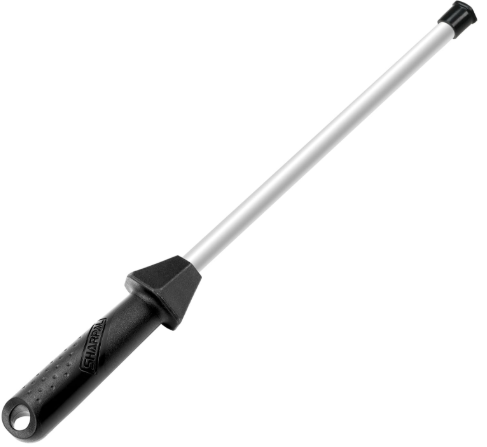
Product Description
The SHARPAL 118H is a professional-grade ceramic honing rod that delivers a very fine edge finish. It features a 3000 grit fine ceramic surface, which is quite polished—meant more for refining and maintaining an edge rather than repairing very dull knives. It has useful safety and design elements: a built-in 20-degree angle guide to help maintain a consistent sharpening angle, a hexagonal hand guard to prevent slipping and rolling, and a removable rubber cap to protect surfaces and reduce chipping or damage if dropped. The overall build is high quality.
Key Features
- 3000 grit extremely fine ceramic surface for polish and edge refinement.
- Built-in angle guide (20°) ensures consistent stroke angle.
- Hexagonal hand guard to improve safety (prevents rolling, protects fingers).
- Removable rubber cap for protection of rod and surfaces.
- Non-toxic, rust-free, strong abrasion resistance.
- Backed by 3-year warranty / customer service.
Pros
- Very fine polishing: gives a razor-sharp finish, great for knives already sharp or lightly dulled.
- Safety features: angle guide and guard reduce user error and chance of slipping.
- Durable ceramic surface: high grit, resistant to wear, good for long term maintenance.
- Protective cap helps reduce risk of damage when stored or accidentally knocked.
Cons
- Because it is very fine, it’s not ideal for restoring very dull or rough blades—medium or coarse grit needed first.
- Higher price (premium), so less cost-effective if you just need occasional sharpening.
- Ceramic is brittle: despite protective features, dropping it or heavy misuse can chip or break it.
- Some users might find the angle guide limiting if they use varied angles or different knife types.
Recommendation
This is an excellent choice for someone who already has knives in good condition and wants to keep them extremely sharp, polished, and maintained. It’s especially useful for chefs, enthusiasts, or people who sharpen often. If you have harder steels or high carbon knives, this rod will shine. But if your knives are dull or you rarely sharpen, you might pair this with a coarser rod.
2. Idahone Fine Ceramic Sharpening Rod (12″, Black Handle)

Product Description
Idahone is a well-known name among culinary professionals, and their fine ceramic sharpening rod is designed with “high alumina” ceramic, which gives it near-diamond hardness. The grit is around 1200-1500, making it more robust for both maintaining and light sharpening of kitchen knives. The handle is made from hard rock maple, giving a traditional wood feel, and it includes a hanging ring for convenient storage. It’s made in the USA.
Key Features
- High alumina ceramic (approx 1200-1500 grit) for both honing and light sharpening.
- Natural handle (hard rock maple) with hanging ring.
- USA-sourced and produced, which often means tighter quality control.
- Generous length: 12 inches gives enough room to do full strokes even on longer blades.
Pros
- Good “all-rounder” grit: not ultra fine, so it can handle a fair amount of wear/dulling.
- Nice handle / craftsmanship; feels comfortable and solid in hand.
- Long enough rod to manage chef knives without needing very small strokes.
- Hanging ring is helpful for storage / keeping safe.
Cons
- Natural wood handles require a bit more care (don’t soak in water, avoid extremes of humidity) or they might degrade.
- At this grit, it won’t give the mirror polish of ultra-fine rods. If you want a super polished finish, you’ll need something finer.
- Ceramic rods are brittle; chances of damage if dropped remain.
- More expensive than simple budget ceramic rods.
Recommendation
This rod is ideal for home cooks or semi-pro users who want a rod that can both maintain an edge and help bring duller knives back without going to a coarse sharpening stone immediately. If you want one reliable rod that balances sharpening vs. honing, this is a strong pick.
3. Green Elephant Ceramic Sharpening Rod, 11-Inch, 1500 Grit
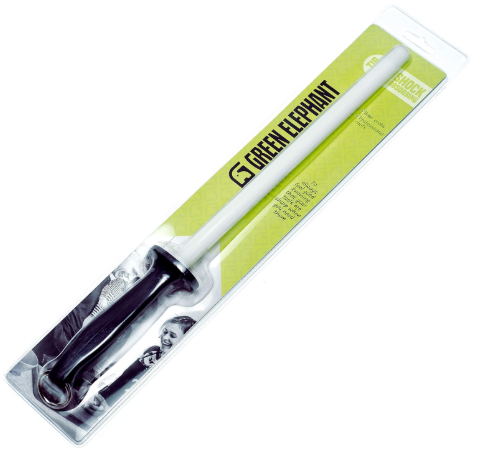
Product Description
The Green Elephant rod is built with durability in mind. It uses ceramic rated at 9 Mohs hardness, with a grit number around 1500, offering good sharpness while still maintaining the edge. It has features aimed at reducing the risk of damage: a silicon seal between the rod and handle plus a plastic end cap to absorb shocks and reduce chance of chipping. The handle is lightweight and ergonomic. It’s designed for frequent use: just 5-10 strokes per side after each hour of knife use to keep blades sharp. Hand-wash only. Comes with a money-back guarantee (30 days).
Key Features
- 1500 grit ceramic, fairly fine, good for honing and light sharpening.
- High hardness (9 Mohs), meaning the ceramic is tough relative to steel.
- Shock-absorbing design: silicon seal + plastic cap reduce breakage risk.
- Lightweight handle for easier, more comfortable use.
- Hand wash only. Money-back guarantee.
Pros
- Very good sharpness vs. durability balance. 1500 grit gives sharp edges without being fragile.
- The shock absorption features are a plus—makes it more resilient to small drops or knocks.
- Comfortable to use; less fatigue due to lighter weight.
- Seems good value for the performance.
Cons
- Hand wash only: more care required.
- Even with shock protection, ceramic can chip—must still treat carefully.
- Might not polish edges as finely as ultra-fine rods.
- Some handles (plastic + silicone) may not be as premium feeling as wood or metal, potentially less comfortable for long sharpening sessions.
Recommendation
A great option if you sharpen often or use knives frequently. This rod is especially useful for someone who wants good performance and some durability without the ultra premium cost. If you travel or move tools around a lot, the shock absorption features make this rod more forgiving.
4. Leriton Ceramic Sharpening Rod, 11-Inch (Plastic & Silicone Handle)
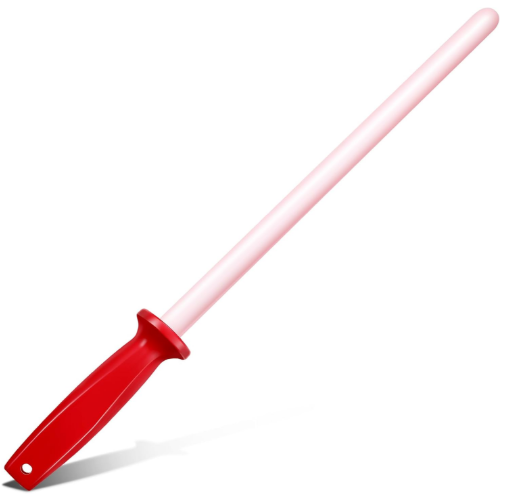
Product Description
The Leriton 11-inch rod offers a relatively long ceramic honing bar (about 10.6 inches of ceramic section) with a handle made of ABS plastic, covered in soft silicone for better grip and comfort. It claims that the ceramic hardness is much greater than typical steel, and has a fine texture. The total length is ~38 cm (~15”) with the bar portion being ~27 cm (≈10.6”). It’s designed for both home and professional cooks. Sold as an Amazon’s Choice item.
Key Features
- ~10.6-inch usable ceramic section; total length ~15 inches.
- Handle: ABS plastic + silicone overlay for improved grip.
- Hard ceramic hardness claimed several times that of steel, with fine texture.
- Lightweight design.
Pros
- Long rod gives good city for larger knives. More full strokes = better sharpening through full edge.
- Comfortable handle grip due to silicone. Less likely to slip.
- Likely more affordable than premium hardwood handle rods.
- Good usability for regular sharpening/honing.
Cons
- Plastic handle may feel less premium and may wear or degrade faster.
- Ceramic still brittle; thicker bar helps, but risk remains.
- Not as fancy finish or polish compared to ultra-fine premium rods.
- Might lack features like angle guides or guards—less precision for beginners.
Recommendation
This is a solid mid-range option for someone wanting a good rod that works well and is comfortable, without spending premium. If you have larger knives and like long strokes, this helps. Good for home cooks who want reliable performance without luxury.
5. Kyocera Advanced Ceramics 9-inch Ceramic Sharpening Rod
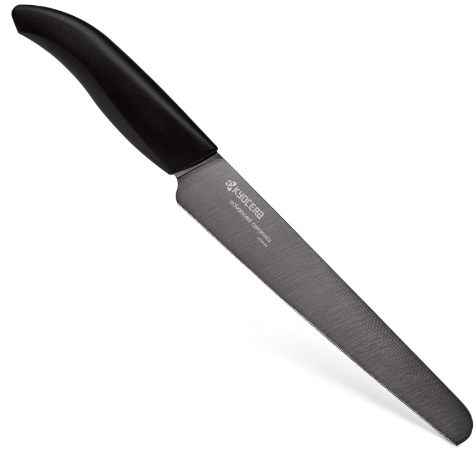
Product Description
Kyocera’s 9-inch rod is made of quality ceramic, known for its sharp, consistent performance. The overall length is about 13.75” including handle, with a 9-inch ceramic rod section. It’s suitable for sharpening and honing various steel knives, scissors, and other blades. It’s designed with a comfortable grip and is a reliable pick from a trusted brand (Kyocera) in ceramic tools.
Key Features
- 9-inch ceramic rod for the sharpening/honing surface.
- Overall length ~13.75 inches (handle + rod) for better leverage and reach.
- Good brand reputation for ceramic tools.
Pros
- Shorter rod section makes it more compact, easier to store, lighter weight.
- High brand trust: Kyocera has good quality control and experience with ceramics.
- Good for smaller knives and everyday kitchen use.
- Offers consistent honing without overdoing abrasiveness.
Cons
- The shorter rod means more small strokes for large knives; less margin of error.
- Not as refined as premium high-grit rods—more suited to maintenance than polish.
- Handle design may be simpler, possibly less protective or ergonomic.
- For very hard steel or very dull knives, coarser tools or stones might still be needed.
Recommendation
Best if you need a reliable, everyday rod from a reputable brand. Great for kitchen work where you want convenience and dependable performance. Good for people who do regular maintainence rather than heavy sharpening. If you mostly use large chef knives, you might prefer a longer rod, but for many kitchens this is enough.
6. Wedgek HXT Thick Ceramic Sharpening Rod & Angle Guides (11-inch)
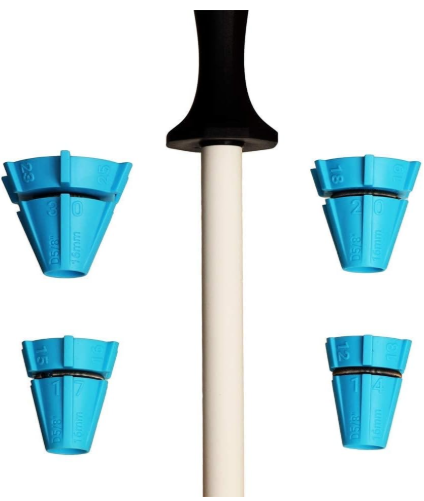
Product Description
The Wedgek HXT is an 11-inch thick ceramic rod set (white ceramic), with included angle guides. The rod is thicker than many standard rods, which helps stability and control. The set includes angle guide cones (NX6) that allow you to position the correct angle (several options). The rod claims a grit around 1500, and the thick build is designed to be more shatter resistant.
Key Features
- 11-inch white ceramic rod, thick diameter for strength / stability.
- Comes with multiple angle guides (NX6), which help you maintain correct sharpening angles (various degree settings).
- The thicker rod section helps resist bending or accidental breakage.
- Designed for both durability and precision.
Pros
- Great for beginners: angle guides help ensure consistent sharpening strokes.
- Thickness adds durability; less likely to snap or break compared to thin rods.
- With good grit, able to both hone and light sharpen edges.
- Solid build for frequent use.
Cons
- Thicker rods may be heavier, more cumbersome for some users.
- Guides add to bulk; might be less convenient for small kitchens or storage.
- Care still required: ceramic can chip.
- Price is likely higher than basic rods without guides.
Recommendation
If you want a rod that gives you more precision (via angle guides) and higher durability (thick build), this is a strong pick. It works well for people learning proper sharpening technique, or for those who want to ensure every stroke is consistent. Especially good for kitchen knives, butcher knives, or users who sharpen often.
Summary Recommendation Table
| Use Case | Best Pick |
|---|---|
| Ultra-polish / finishing | SHARPAL 118H |
| All-round home kitchen with strong edge retention | Idahone Fine Ceramic |
| Durability + sharpness balance | Green Elephant |
| Comfortable grip + cost-effective | Leriton |
| Trusted brand & daily use in smaller kitchen | Kyocera 9-inch |
| Beginner + precision control | Wedgek HXT with angle guides |
If you want, I can pull up current pricing, availability to Bangladesh / shipping, or compare these side by side in a table for your readers.
How to Use a Ceramic Sharpening Rod
Using a ceramic sharpening rod is simpler than it looks. With a little practice, you’ll be able to keep your knives razor-sharp without professional help. Here’s a clear step-by-step guide:
Step 1: Choose the Right Rod
- Pick a rod that is at least 2 inches longer than your knife’s blade.
- Make sure the rod is clean and free of steel residue before you begin.
Step 2: Position the Rod
- Hold the rod vertically with the tip resting on a cutting board or a non-slip surface.
- Keep your non-dominant hand on the handle and your dominant hand on the knife.
Step 3: Find the Correct Angle
- The ideal sharpening angle for most kitchen knives is 15–20 degrees.
- Imagine the knife is almost flat against the rod—then tilt it slightly outward to achieve this angle.
Step 4: Sharpen the First Side
- Starting near the knife’s heel (closest to the handle), place it against the top of the rod.
- With light, steady pressure, draw the knife down and across the rod in a sweeping motion, ending at the tip.
- Think of it as “shaving” the rod with the edge of your knife.
Step 5: Alternate Sides
- Switch to the opposite side of the blade and repeat the same motion.
- Continue alternating sides for 5–10 strokes per side, depending on how dull the knife is.
Step 6: Wipe and Test the Edge
- After sharpening, wipe your knife clean with a damp cloth to remove any metal particles.
- Test sharpness by slicing through paper, tomatoes, or onions.
Safety Guide for Using Ceramic Sharpening Rods
Ceramic rods are extremely effective but require careful handling. Here are some key safety tips:
1. Stabilize the Rod
- Always place the rod tip firmly on a cutting board or non-slip mat.
- Never “freehand” hold the rod in the air—it’s harder to control and increases the risk of accidents.
2. Maintain a Controlled Angle
- Don’t press too hard; ceramic rods remove metal gently.
- Heavy pressure can cause uneven edges and increase the chance of slipping.
3. Use Light, Smooth Strokes
- Fast, jerky motions make it easy to lose control of the blade.
- Keep your movements slow and consistent.
4. Protect Your Fingers
- Keep your guiding hand (holding the rod) behind the finger guard or handle.
- Always sharpen away from your body, never toward yourself.
5. Handle the Rod with Care
- Ceramic rods are hard but brittle—don’t drop them.
- Store in a sheath, protective case, or hang it safely when not in use.
6. Clean Regularly
- Residue builds up quickly and reduces effectiveness.
- Use a ceramic rod eraser, soft sponge with soapy water, or a baking soda paste to clean it.
- Dry completely before storing.
7. Don’t Use on Certain Knives
- Ceramic rods are best for stainless steel or softer carbon steel knives.
- For very hard Japanese knives, serrated blades, or ceramic knives, use the manufacturer’s recommended sharpener instead.
✅ Pro Tip: Consistency is more important than speed. Even professional chefs sharpen slowly and steadily—rushing only leads to accidents or uneven edges.
FAQs About Ceramic Sharpening Rods
1. What’s the difference between a ceramic sharpening rod and a steel honing rod?
A steel honing rod mainly realigns the knife’s edge without removing much metal. A ceramic rod, on the other hand, actually sharpens by grinding away tiny amounts of metal while also refining the edge. That’s why ceramic rods keep knives sharper for longer.
2. How often should I use a ceramic sharpening rod?
For home cooks, using a ceramic rod once every 1–2 weeks is usually enough. If you cook daily, a quick honing session after every major use (5–10 strokes per side) will keep knives consistently sharp.
3. Can I use a ceramic sharpening rod on any type of knife?
Ceramic rods are ideal for stainless steel and softer carbon steel knives. They’re not recommended for:
- Serrated knives
- Ceramic knives (too hard for ceramic rods)
- Extremely hard Japanese steel knives that require water stones
4. What grit is best for a ceramic sharpening rod?
- Fine grit (1000+): Best for polishing and maintaining sharp edges.
- Medium grit (600–1000): Great for sharpening slightly dull knives.
- Coarse grit (below 600): Better for repairing very dull or chipped knives.
Most home cooks do best with a medium-to-fine grit rod in the 1000–1500 range.
5. How do I clean a ceramic sharpening rod?
Steel residue builds up quickly on ceramic rods. To clean:
- Use a ceramic rod eraser (most effective).
- Or scrub with a baking soda paste and soft brush.
- Rinse with warm, soapy water and dry thoroughly before storing.
6. Do ceramic rods break easily?
Ceramic rods are extremely hard but brittle. If dropped on a hard surface, they can crack or chip. That’s why many premium models include protective tips, shock-absorbing features, or storage sheaths. Always handle with care.
7. What length ceramic rod should I buy?
Choose a rod that’s 2 inches longer than your longest knife blade.
- 8-inch rods: Good for smaller utility or santoku knives.
- 10-inch rods: Best all-around option for most kitchens.
- 12-inch rods: Professional choice for longer chef’s or butcher knives.
Conclusion
A sharp knife isn’t just about speed—it’s about safety, precision, and enjoyment in the kitchen. A ceramic sharpening rod is one of the easiest, most effective tools you can own to maintain razor-sharp edges without the hassle of complicated sharpening systems.
When shopping for the best ceramic sharpening rod, focus on length, grit level, handle comfort, and durability. Fine-grit rods are great for polishing sharp knives, while medium-grit rods are more versatile for general upkeep. Always handle with care, clean regularly, and store properly to maximize the life of your rod.
Whether you’re a weekend home cook or a professional chef, investing in a quality ceramic sharpening rod means your knives will always be ready for action—making cooking smoother, safer, and far more enjoyable.